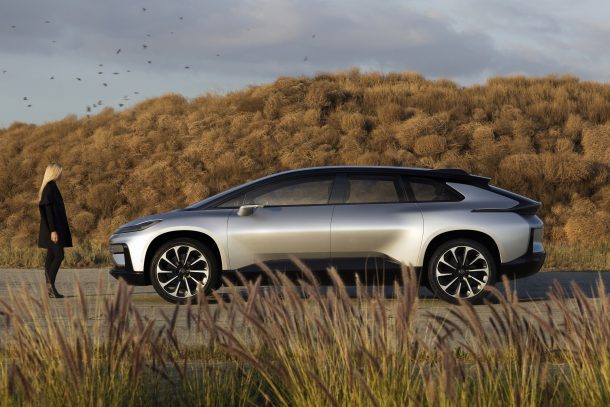Faraday Future Delivered an Electric Vehicle With Only a Single Embarrassing Moment

Despite a year’s worth of absolutely scathing publicity and countering hype from the company, Faraday Future finally presented the world with an electric vehicle at the Consumer Electronics Show last night.
The car — called the FF 91 — would become the quintessential futuristic vehicle if it lives up to even a third of Faraday’s claims. Faster than any Tesla, with better range, more sensors, and an incredible user recognition program, it was an extraordinary example of what Faraday needs to bring to the table in order to continue existing.
Faraday’s presentation contained a number of strange moments that touched upon the myriad of criticisms against it, without addressing anything too directly. After two countdown timers, Senior Vice President of R&D Nick Sampson took to the stage to remind the press of Faraday’s achievements over the past two years — suggesting its incongruous structuring and clean-slate history were assets. Sampson presented a short film of FF’s factory construction locale in Nevada — currently stalled due to non-payment — and the following speaker introduced North Las Vegas’ mayor in a sign of good faith.
The troubled startup claims its 91 is equipped with a dozen ultrasonic sensors, two modems, two antennae, and a baker’s dozen worth of short-range radar receivers. It also has three-dimensional LIDAR housed a blue-ringed puck that pops up from the hood of the car. That many sensors should be sufficient for vehicular autonomy, and Faraday used them to park the 91 using an app installed on a phone. While slow moving, it managed to back into a “random” parking space without much hassle.
The parking display segued seamlessly into Farday’s face of electrical engineering, Peter Savagian, taking the stage. Despite having only joined the company in August, Savagian’s enthusiasm appeared boundless. He touted the FF 91 as possessing the largest and most dense battery pack available, containing 130 kilowatt hours of energy. As things currently stand, that makes it superior than the best offering from Tesla. FF claimed the power pack would provide the car with a range of 378 miles, or more if drivers stuck to a constant average speed of 55 miles an hour. A proposed open charging system allows the car to make use of 110 or 240 volt AC at-home chargers. It is also supposed to be capable of 200 kilowatt DC quick-charging capability, with the eventual promise of wireless charging.
Savagian, who once worked on General Motor’s defunct EV1 program, was even more excited about the 91’s performance figures. At a claimed 1,050 horsepower and a 2.39-second 0-to-60 time, Faraday Future was happy to exhibit the car’s straight-line speed against a Bentley Bentayga, Ferrari 488 GTB, and a couple of Tesla’s best. While we didn’t actually see the finish line or know who was keeping score, the FF 91 narrowly beat out the Model S in Ludicrous Mode.
Afterward, Faraday Future finally rolled out a silver “production” model — the previous two black and white cars appeared to be specifically for demonstrative purposes — and the presentation hit a snag. Rich person and LeEco godfather, Jia Yueting, stepped out of the metallic 91 to prompt the “auto valet park” feature, only to see the car malfunction on stage.
“OK, it seems like it’s a little bit lazy tonight,” Sampson said of the car before inviting Jia to give some remarks about the company.
However, after Jia’s somewhat difficult to understand speech, the lights dimmed and the car eventually took its place center stage. “As a new baby, she’s often very, very timid,” Sampson joked.
Speaking to The Verge post-show, Sampson commented on the matter by saying “It’s a complex situation … We knew there were technical challenges. If you look up at the roof of this building, there’s a lot of structure up there that inhibits some of the signals the car needs to be able to self-drive.”
While not an utter disaster, it was what every cynical journalist was waiting for and proof that Faraday Future still isn’t as far along in the process as they’d like us to believe. The fact that the car also didn’t drive itself offstage was telling, and so was the decision to completely gloss over the vehicle’s interior. There were also a scant number of details given on the “FF ID” Bluetooth and facial recognition software that allows all FF cars to identify you — offering keyless entry, voice control, entertainment solutions, and internet while it continuously but “non-intrusively” learns about you and saves your preferences.
In fact, the impressive/terrifying-sounding features was the absolutely staggering level of connectivity the car was supposed to offer. However, Faraday never showcased any of that, either.
Pricing remains a mystery, as does how it will build the cars without a completed factory. However, you can make a reservation on Faraday’s website for a refundable $5,000. The first 300 production FF 91s come in a unique color and are slated for production in 2018.
[Images: Faraday Future]

A staunch consumer advocate tracking industry trends and regulation. Before joining TTAC, Matt spent a decade working for marketing and research firms based in NYC. Clients included several of the world’s largest automakers, global tire brands, and aftermarket part suppliers. Dissatisfied with the corporate world and resentful of having to wear suits everyday, he pivoted to writing about cars. Since then, that man has become an ardent supporter of the right-to-repair movement, been interviewed on the auto industry by national radio broadcasts, driven more rental cars than anyone ever should, participated in amateur rallying events, and received the requisite minimum training as sanctioned by the SCCA. Handy with a wrench, Matt grew up surrounded by Detroit auto workers and managed to get a pizza delivery job before he was legally eligible. He later found himself driving box trucks through Manhattan, guaranteeing future sympathy for actual truckers. He continues to conduct research pertaining to the automotive sector as an independent contractor and has since moved back to his native Michigan, closer to where the cars are born. A contrarian, Matt claims to prefer understeer — stating that front and all-wheel drive vehicles cater best to his driving style.
More by Matt Posky
Latest Car Reviews
Read moreLatest Product Reviews
Read moreRecent Comments
- Tassos Under incompetent, affirmative action hire Mary Barra, GM has been shooting itself in the foot on a daily basis.Whether the Malibu cancellation has been one of these shootings is NOT obvious at all.GM should be run as a PROFITABLE BUSINESS and NOT as an outfit that satisfies everybody and his mother in law's pet preferences.IF the Malibu was UNPROFITABLE, it SHOULD be canceled.More generally, if its SEGMENT is Unprofitable, and HALF the makers cancel their midsize sedans, not only will it lead to the SURVIVAL OF THE FITTEST ones, but the survivors will obviously be more profitable if the LOSERS were kept being produced and the SMALL PIE of midsize sedans would yield slim pickings for every participant.SO NO, I APPROVE of the demise of the unprofitable Malibu, and hope Nissan does the same to the Altima, Hyundai with the SOnata, Mazda with the Mazda 6, and as many others as it takes to make the REMAINING players, like the Excellent, sporty Accord and the Bulletproof Reliable, cheap to maintain CAMRY, more profitable and affordable.
- GregLocock Car companies can only really sell cars that people who are new car buyers will pay a profitable price for. As it turns out fewer and fewer new car buyers want sedans. Large sedans can be nice to drive, certainly, but the number of new car buyers (the only ones that matter in this discussion) are prepared to sacrifice steering and handling for more obvious things like passenger and cargo space, or even some attempt at off roading. We know US new car buyers don't really care about handling because they fell for FWD in large cars.
- Slavuta Why is everybody sweating? Like sedans? - go buy one. Better - 2. Let CRV/RAV rust on the dealer lot. I have 3 sedans on the driveway. My neighbor - 2. Neighbors on each of our other side - 8 SUVs.
- Theflyersfan With sedans, especially, I wonder how many of those sales are to rental fleets. With the exception of the Civic and Accord, there are still rows of sedans mixed in with the RAV4s at every airport rental lot. I doubt the breakdown in sales is publicly published, so who knows... GM isn't out of the sedan business - Cadillac exists and I can't believe I'm typing this but they are actually decent - and I think they are making a huge mistake, especially if there's an extended oil price hike (cough...Iran...cough) and people want smaller and hybrids. But if one is only tied to the quarterly shareholder reports and not trends and the big picture, bad decisions like this get made.
- Wjtinfwb Not proud of what Stellantis is rolling out?




































Comments
Join the conversation
FF didn't "deliver" anything other than a presentation. In the automotive world, using the term "delivered" suggests a consumer was sold and received a production vehicle. At least you used quotes around "production", as it's far from that either. They don't even have a production facility yet. At best, the vehicle could be considered a prototype.
Who do you want to hang with? The friend who says "hey check out my new FF91, it has Twitter and parks itself and I can drive it with my phone," or the friend who shows up in his old F150 and says, "get in, we're going to drink beer and meet girls."